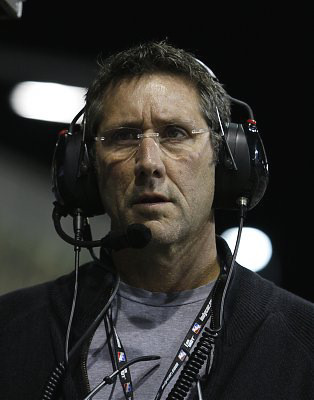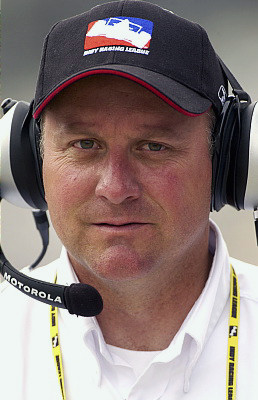The Way It Is/ Some lessons for Indy car racing's future
by Gordon Kirby It's no secret that the next couple of years will be tough for Indy car racing as it tries to rebuild and regain momentum under the unchallenged control of Tony George and the Indy Racing League. Collateral damage from the IRL/Champ Car unification continues to shake-out with substantial layoffs at Cosworth USA in California and Forsythe Racing suspending operations and releasing Paul Tracy because Jerry Forsythe says it's impossible to sell sponsorship for the IRL series.
It's no secret that the next couple of years will be tough for Indy car racing as it tries to rebuild and regain momentum under the unchallenged control of Tony George and the Indy Racing League. Collateral damage from the IRL/Champ Car unification continues to shake-out with substantial layoffs at Cosworth USA in California and Forsythe Racing suspending operations and releasing Paul Tracy because Jerry Forsythe says it's impossible to sell sponsorship for the IRL series.
As the damage continues to accumulate, difficult choices will have to be made this sumer over which IRL races to keep and which former Champ Car races to adopt or revive in 2009. Equally difficult decisions also will have to be made over the next year or two in determining the 2011 rules and the shape and sound of the Indy car of the future.
These decisions will determine Indy car racing's content, look and appeal, and provide the essential framework for the sport's energetic rebirth or consign it to a life of mediocrity and stagnation. Let's hope that some inspired thinking will provide the basis for real leadership capable of pushing Indy car racing forward.
I gained some perspective last month on the debate about Indy car racing's future rules by talking to a wide range of engineers at Daytona. These people built their careers in CART, F1 and sports car racing, but have been drawn into NASCAR in recent years by the budgets to fund serious engineering programs like those that used to exist in CART and continue to thrive almost uncontrollably in Formula 1.
Pete Spence is vice president and technical director of Toyota Racing Development (TRD) USA, based in Costa Mesa, California. Spence is from Northern Ireland and was educated at Scotland's Aberdeen University. After graduating, he went to work at Cosworth and eventually ran Cosworth's Formula 1 HB engine department supplying engines to McLaren in 1993. Spence had the pleasure of working with Ayrton Senna that year but when McLaren switched to Peugeot engines he decided to move over to Cosworth's CART Indy car program with the XB turbo V-8, swapping positions with Rob White who had spent a few years in America and now is with Renault's F1 team.

© LAT USA
"I think it's a good question and I think it needs someone smarter than me to answer it confidently," Spence said. "There's one thing for sure and that is the NASCAR model is healthy and stays in balance. The open-wheel model got unbalanced for a whole lot of detail reasons and the ultimate solution of how to balance it out again is very complex. It requires some well-funded people with a lot of open-wheel racing experience to make the regulations for the series with a longterm vision so that the character of the racing is interesting to the fans yet the technology of the cars is also interesting to the fans.
"I think Formula 1 has tried to look at NASCAR and decide what to adopt," Spence continued. "I think a lot of people from the open-wheel world have been forced to look at the NASCAR model because of the need to better police their own series and they've adopted elements of it. But I think NASCAR has a long history of doing that, and so they have their own understanding of what's necessary to balance it out.
"If you look at the positive comments that people are now making about the Car of Tomorrow," he added, "the general impression is that people seem to like it. The racing doesn't appear to be negatively changed by it. Maybe it's been made incrementally better."
Spence says he learned plenty of lessons during his eight years in CART with Cosworth and Toyota. "I came from Formula 1 into CART and my immediate reaction was, 'Wow, what a great series, because all the team owners were able to have a stake in it and participate in making the rules.' And how wrong I was! That was in 1994, and by 2002, I would say I had let go of my ideals and grown-up because they demonstrated sufficient individual greed to kill the series."
Certainly, greed was one factor allied with a concomitant inability to dictate to and control the manufacturers. Let's not forget that a key element in CART's failure was a technical brouhaha in 2001 between Toyota, Honda and Ford/Cosworth over illegal turbo plenum chambers designed to override the pop-off valve. A suit and court case ensued and in company with the team owners continual vacillation in determining the future engine rules this affair led to Toyota and Honda pulling out of CART. In the middle of these legal squabbles there were accusations of theft of intellectual property by engineers who had left one of the three manufacturers to join a competitor, a precursor in fact, to last year's 'Stepneygate' saga in F1.
So there are many lessons that need to be applied to the future IRL formula from CART and Champ Car's failed, twenty-nine year experiment in democracy. Attracting and keeping high-powered manufacturers will be a challenge for the IRL, as it already has proven to be and just as it was for CART. The IRL already has been through Oldsmobile, Nissan, Toyota and Chevrolet, and it will require strong, savvy leadership like we've never seen in American open-wheel racing to attract and maintain a fleet of committed manufacturers.

© LAT USA
"It was really interesting racing back when it was Michael versus Al Jr. In those days they had gobs of horsepower and thousands of pounds of downforce and were diving down the inside each other going into turn one at Milwaukee. They could outbrake each other and they had the confidence to go down the inside."
But CART's team owners and technical people struggled with the rules as they tried to slow-down the cars on the ovals. At one point, six or seven years ago, they cut downforce so much that most oval races became processions with the leaders unable to pass the lapped cars when they caught them. Then Champ Car went the opposite direction and put on too much downforce for the ovals, much like the IRL formula, before quitting oval tracks altogether.
"Take away the downforce and you take away the driver's confidence and you get a procession," Spence remarked. "Keeping the power, grip and downforce in balance is the key because inevitably, the performance goes up, the grip goes up, and the downforce goes up. So you have to either start adding drag, or take away engine capacity, and of course you're always under pressure not to change too much because it's expensive."
One of the benefits of having a turbocharged engine was that the sanctioning body could mess with the boost pressure to control increases in power as the manufacturers competed against each other. Spence believes it's a good reason for the IRL to go the turbo route in the future.
"You really need to start with a turbocharged formula with a massive amount of boost with a regular regimen of knocking back the boost," Spence commented. "That's basically what we defined at one point in CART with the engine manufacturers involved--a very small capacity V-8 with very high rpm to keep it interesting technically and very high boost and an annual regimen of boost reductions which allowed development. Then you have to have some way of managing the downforce versus drag and I don't know that anyone has done that very well. It's very, very hard."
Although Spence, like all engineers, is a devotee of electronics, he wonders if it might not be better to ban digital technology from racing. "For people in almost every walk of life, the implementation of digital control technology has changed everything," Spence ruminated. "It's had such a profound effect. The active suspension era of the early nineties was more about the implementation of high-speed digital control systems to modern day racing cars. A few years earlier it was all about aluminum chassis and oil-filled shocks. The cars were just regular, high-tech go-karts.
"Maybe what we need to do, as much as I hate the idea as an engineer, is to take the digital controls away and force it back into the mechanical development regimen. Let's see the creativity of the technical people solely on the mechanical side."
Despite being a true-blue engineer, Spence believes the sport must focus on the human being--the driver--if it is to continue to thrive.
"We're trying to find technical ways to control the upgoing march of the performance of the vehicles such that the human being is still the weakest link and therefore skill and talent still comes to the fore," Spence commented. "That is the challenge in a nutshell and it's very difficult because there are a lot more clever engineers working on increasing the performance in individual specific elements independent of the big picture than there are clever, smart people working on adding regulations to maintain the balance."
Spence makes the age-old point that the race teams and manufacturers always hire and pay for smarter engineers than the sanctioning body. "It's more comfortable to be a poacher than a game-keeper," Spence remarked. "Until the day you can pay the poacher enough money to be the game-keeper and give him a bigger building than all the poachers.
"The challenge is to continue the balance relative to the human being," he added. "So many of the open-wheel performance parameters have advanced so much relative to the capabilities of a human being, I think the challenge there is to maintain a level of technology which makes the vehicles interesting to the fans while inhibiting the development such that the balance of the performance of the vehicle versus the driver's ability to control it and the driver's confidence all stays in balance so that people can still pull out to pass or use their skill to go faster than the next guy. At the end of the day, we're here to see a race between human beings."
Modern technology, progress, speed and the human element. How to combine all these factors to create the right Indy car formula for the future? The challenge for the IRL is clear.
Auto Racing ~ Gordon Kirby
Copyright 2008 ~ All Rights Reserved
Copyright 2008 ~ All Rights Reserved
Top of Page